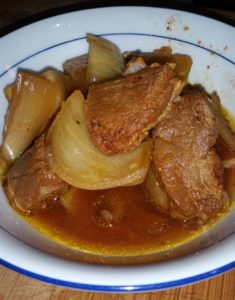I’ve been a bit obsessed with Mexico City recently following a trip in November. It’s pretty fantastic (if you can handle the smog and speak at least a bit of Spanish) – great art, great culture, amazing food, etc. – I’m going back this month. But in the meantime, back up here in the cold, I wanted to bring myself back to a bit of a warmer state of mind, and what better excuse to use everyone’s favorite winter warmer, the slow cooker?
So I decided to try a spin on a DF classic – al pastor. So I polled a couple Mexican friends (ok, exactly two) for a recipe, and combining them got a semi-coherent list of ingredients with vague proportions. But it sounded good, and I’m not big on precise measurements anyhow. Also note that al pastor is generally defined by use of the guajillo chili, which I didn’t
have handy. I used chipotle. I also had no pineapple juice, so that got mucked about a bit, and obviously I slow-cooked instead or spit-grilling.
You read the title, right?
I also added the onion because I thought it seemed right. It was.
I used:
Product:
- 2 lbs. pork butt country ribs, separated and stabbed repeatedly
- 1/2 yellow onion, quartered
- 11 oz. cubed fresh pineapple
Marinade:
- 2 tbsp. achiote (anatto) seed, ground
- 2 tbsp. ground chipotle
- 1 tbsp. garlic powder
- 1 tbsp. oregano
- 1 tbsp. cumin
- 1 tbsp. salt
- 1 tbsp. pepper
- 1 cup cider vinegar
- 3/4 cups water
- 1 tbsp. agave nectar
Preparation is wonderfully simple: put all the ingredients in a glass or ceramic bowl, cover and marinate overnight. In the morning before leaving for work, I poured everything into my trusty slow cooker, and set it on low for 9.5 hours (its longest setting, just because it’s not like I was getting home in less than 11) . I arrived home that evening to a gorgeous aroma from the pot, now happily keeping things warm, from which I heaped lovely, fall-apart tender pork. It was truly delicious alone, but over some rice (I suspect hominy would be good too) it was really awesome.
The cooked marinade, by the way, is a keeper: this may become a go-to barbecue sauce for me: transfer it to a saucepan and let reduce. Thicken with cornstarch or flour, and toss the pork back in, you could make tacos. I’m just sayin’.
Buen provecho!
– MAW





 Guest blogger Maya reports great success with this family recipe – however, she warns that you *really* need to take your time with this, especially taking care to cook slowly and not let things burn. Indian cuisine, she reminds us, requires constant attention and no multi-tasking.
Guest blogger Maya reports great success with this family recipe – however, she warns that you *really* need to take your time with this, especially taking care to cook slowly and not let things burn. Indian cuisine, she reminds us, requires constant attention and no multi-tasking.





